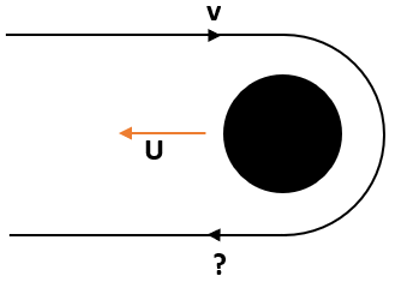This set of Spaceflight Mechanics Multiple Choice Questions & Answers (MCQs) focuses on “Lunar Trajectories – Gravity Assist Maneuver”.
1. What is the main advantage of using a gravity assist maneuver?
a) Reduce maneuver time
b) Increase fuel efficiency
c) Make the trajectory accurate
d) Keep the velocity of spacecraft constant
View Answer
Explanation: Gravity assist maneuver also known as fly-by or swing-by makes use of the gravity of a planet, sun or moon to propel the spacecraft. This leads to saving the propellant mass and increase the efficiency. The satellite/spacecraft enters planet’s sphere of influence along hyperbolic arrival asymptote and leaves the planet along hyperbolic departure asymptote.
2. Which of these is not a result of carrying out a gravity assist maneuver?
a) Accelerate the spacecraft
b) Deaccelerate the spacecraft
c) Redirect the path
d) Alter the orbital time
View Answer
Explanation: Using gravity assist maneuver, the spacecraft’s speed can be altered i.e., either accelerate or deaccelerate. This is also used to alter the path using the gravitational pull. But the aim of carrying out gravity assist maneuver is not to alter the orbital time as it is dependent on various other factors.
3. While entering the planet’s gravitational sphere what happens to the velocity of the spacecraft?
a) Increases
b) Decreases
c) Remains same
d) Alters periodically
View Answer
Explanation: Every celestial body has its own gravitational sphere where its gravitation is dominated as compared to other body’s gravitational field. When the spacecraft enters this sphere, there is a strong pull due to gravity thus increasing its velocity.
4. While leaving the planet’s gravitational sphere what happens to the velocity of the spacecraft?
a) Increases
b) Decreases
c) Remains same
d) Alters periodically
View Answer
Explanation: When the spacecraft leaves the planet’s sphere of influence along the hyperbolic escape trajectory, it experiences a strong pull due to the planet’s gravity. This decreases the velocity of the spacecraft due to reversibility of orbits.
5. Powered slingshot is more effective in increasing the velocity of the spacecraft compared to the gravitational slingshot.
a) True
b) False
View Answer
Explanation: A powered slingshot makes use of powering engine at the periapsis while encountering a planet. This increases the velocity way more as firing up the engine burns the fuel which provides extra thrust and it also decreases mass.
6. Which planet’s assist was not used by Voyager 2 to carry out interspace mission?
a) Mars
b) Jupiter
c) Saturn
d) Uranus
View Answer
Explanation: Voyager 2 was one of the first interspace missions which made use of gravity assist by Jupiter, Saturn, Uranus and Neptune. They were all aligned perfectly which is a rare occurrence.
7. If a spacecraft approaches a planet which is moving with a velocity U, then what is the velocity of the spacecraft acquired by gravitational slingshot?

a) v + U
b) U – v
c) 2U + v
d) v – 2U
View Answer
Explanation: When a spacecraft approaches a planet/body other than the direction of the body moving, there’s a change in the velocity occurring due to energy transfer. Thus, there is a change in velocity without consuming any fuel. When the spacecraft approaches planet at 180 deg difference between their velocities, it leaves the planet by gaining the speed and exiting the orbit with a much higher velocity. The exit velocity is equal to the original velocity plus the planet’s velocity relative to the planet. Thus, it is U + (U + v) = 2U + v.
8. What is the formula to compute the change in orbital energy if the spacecraft begins burn when travelling with velocity v and burns engine to change velocity delta-v?
a) ΔEorbit = vΔv
b) ΔEorbit = \(\frac{1}{2}\) Δv2
c) ΔEorbit = vΔv – \(\frac{1}{2}\) Δv2
d) ΔEorbit = vΔv + \(\frac{1}{2}\) Δv2
View Answer
Explanation: When a spacecraft undergoes a gravitational slingshot while simultaneously powering the engine to achieve a higher delta-v, it is known as a powered slingshot. The formula to compute change in the orbital energy in a powered slingshot is:
ΔEorbit = vΔv + \(\frac{1}{2}\) Δv2
When the spacecraft is closer to the body while burning the propellants, the burn becomes more effective.
9. What is the setback of using the gravitational slingshot maneuver to send spacecraft to another planet?
a) Less economical
b) More fuel consumption
c) Limitation of correct alignment of planets
d) Time consuming
View Answer
Explanation: On of the major setbacks for using the gravitational slingshot is that there are very rare occurrences for the planets to align in way expected for the optimum slingshot to occur. It can take several years, decades to achieve a perfect alignment of the celestial bodies.
On the other hand, slingshot mostly accelerates the spacecraft thus making it less time consuming. And since it makes use of lesser fuel, it is ore economical.
10. When the spacecraft provides burn at the periapsis of the planet within the atmosphere, it produces a higher acceleration while exiting.
a) True
b) False
View Answer
Explanation: Closer the spacecraft approaches and provides burn at the periapsis, faster is the exit velocity. But there is an exception, if it is too close to the planet such that it is within the atmosphere layer, it tended to deaccelerate the spacecraft due to the drag and ends up with lesser exit velocity.
Sanfoundry Global Education & Learning Series – Spaceflight Mechanics.
To practice all areas of Spaceflight Mechanics, here is complete set of 1000+ Multiple Choice Questions and Answers.
If you find a mistake in question / option / answer, kindly take a screenshot and email to [email protected]
